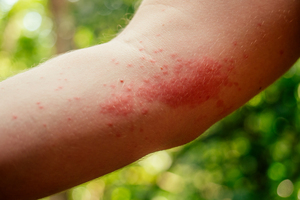Key points
- Splinters should be removed promptly to avoid infection and further discomfort.
- The most common method for splinter removal involves using tweezers and a needle.
- Splinters that are large, deep, or near sensitive areas like the eye may require medical attention.
- Alternative methods for removing splinters include using duct tape, a baking soda paste, or an Epsom salt soak.

Splinters are a huge bummer. At best, they’re irritating. At worst, they can get infected and turn into a much bigger issue. A splinter is a small foreign body that becomes wedged under the first layers of skin. They note that a common kind of splinter is a wood splinter (a small, sharp piece of wood that embeds under the skin). Some people call a splinter a sliver—these terms both refer to the same thing. A splinter usually causes some mild pain or discomfort, but luckily there are several ways that you can painlessly remove splinters at home.
But first, here’s what not to do when removing a splinter
Don’t try to “squeeze” it out. You’ll risk splitting the splinter into parts which will make it much more difficult to remove. Also, it’s best not to try to remove certain kinds of splinters at home. If the splinter is very large, deep, infected, or located on or near your eye, it will likely require medical attention. Splinters that go straight into the skin are also notoriously tricky to remove by yourself. If any of these things are going on, make an appointment at your local urgent care center and they’ll fix you right up.
How to Remove a Splinter
A tried and true way to remove a splinter: tweezers and a needle
Most splinters can be taken care of at home with the good old tweezers and needle approach. But remember, it’s best to deal with a splinter right away. You don’t want it to burrow deeper into the skin or get infected.
1. Inspect the splinter
The first thing you should do is inspect the splinter to see which direction it entered the skin and whether a portion of it is poking out or not. Using a magnifying glass is super helpful here (and a good thing to have in your first aid kit). Inspecting your splinter first will help you decide how to proceed in getting it out.
2. Wash and dry the area
After you've inspected your splinter, clean the area of your splinter with soap and water to help prevent infection. You should also clean your tools (such as your tweezers or needles). The American Academy of Dermatology recommends that you clean any tools with rubbing alcohol, which will help sterilize them.
3. Use tweezers to remove the splinter
If a section of the splinter is visible you can use the tweezers to pull it out the same direction it went in.
4. Use a small sterilized needle to remove the splinter
If the entire splinter is fully embedded in the skin, however, you’ll need to use a small needle to get it out. Gently pierce the surface of the skin at one end of the splinter and keep lightly pushing out part of the splinter until you can see the tip. Then use your tweezers to remove it.
5. Clean and apply petroleum jelly
The American Academy of Dermatology recommends that you apply petroleum jelly and use a bandage to cover the area where your splinter used to be until it heals.
How to get a splinter out without tweezers
Tweezer method not working? Not a problem. We've got 6 more easy ways that you can try to remove that pesky splinter.
- Try pulling the sliver out with duct tape. Sticky tape (like duct tape) can work great to remove shallow splinters. Simply cover the tip of a splinter with a small piece of tape and leave it on for 30 minutes (this will allow the tape adhesive to adhere well to the splinter). Then slowly remove the tape in the opposite direction that the splinter entered the skin. The tape should stick to the end of the splinter and pull it free as you peel the tape away. Pro tip: soak the area in water first to soften the skin and make the sliver easier to remove.
- Use a solution to draw out the splinter. Make a paste using one tablespoon of baking soda and one tablespoon of water. Cover the skin around the splinter with the paste. Then, put a bandage over the area and leave it alone for at least 24 hours. The baking soda solution should work to pull the splinter up to the surface, making it easier to pull out with tweezers easily and painlessly.
- You can also try using hydrogen peroxide or an Epsom salt soak to help draw the splinter closer to the surface. This method can work on large splinters but may be less effective if the splinter is too deep. Epsom salts can also sometimes help bring the splinter up closer to the surface of the skin.
Risks of not Removing a Splinter
Small splinters may eventually work their way out of the body on their own, according to the National Library of Medicine (NLM). Some, however, can be deep enough or big enough to cause prolonged discomfort if they aren't removed. Additionally, Medical News Today notes that any wound containing a foreign object (including splinters) carries a risk of introducing bacteria, including tetanus (a rare and often fatal condition).
Splinters can also cause localized infections that may cause pain, tenderness, and swelling around the sliver, or cause pus to leak from the puncture wound. The skin could also heal over the splinter, making it much more difficult to remove down the line. If your splinter is big or infected, or if you do not feel comfortable trying to remove it yourself, you can visit an urgent care near you to remove it safely for you.
Final Takeaways
Getting a splinter out doesn’t have to be a painful process. Depending on where the splinter is and how deep it goes, you may be able to get it out of your skin by yourself. However, if you’re feeling iffy or suspect that the wound may be infected, take out the guesswork and book an appointment at one of Solv's urgent care centers.
FAQs
What is a splinter?
A splinter is a small foreign body, often a piece of wood, that becomes lodged under the skin, causing discomfort or pain.
What should I avoid doing when trying to remove a splinter?
Do not try to squeeze out the splinter as this may split it into smaller pieces, making it harder to remove.
What is the recommended method for removing a splinter at home?
The most common method involves using a needle and tweezers. First, inspect the splinter, then clean the area and your tools. If part of the splinter is visible, use tweezers to remove it. If it's fully embedded, use a needle to expose the tip, then use tweezers.
What alternatives are there if I can't remove a splinter with tweezers?
You can try using duct tape, a baking soda paste, or an Epsom salt soak to draw the splinter closer to the skin's surface.
When should I seek medical attention for a splinter?
If the splinter is large, deep, infected, or located near your eye, it's best to seek medical attention. Also, if you feel uncomfortable trying to remove it yourself, it's advisable to see a healthcare professional.
Should I go to the doctor if I can’t get my splinter out?
Yes. Most urgent care centers can take care of difficult splinters right away. You should seek medical care if the splinter won’t come out, if it’s on or near the eye, or if it’s looking infected. Signs that a splinter is infected include increased pain or redness, hardened skin, a white or yellow discharge, an associated fever or swollen lymph nodes, or red streaking from the affected area.









